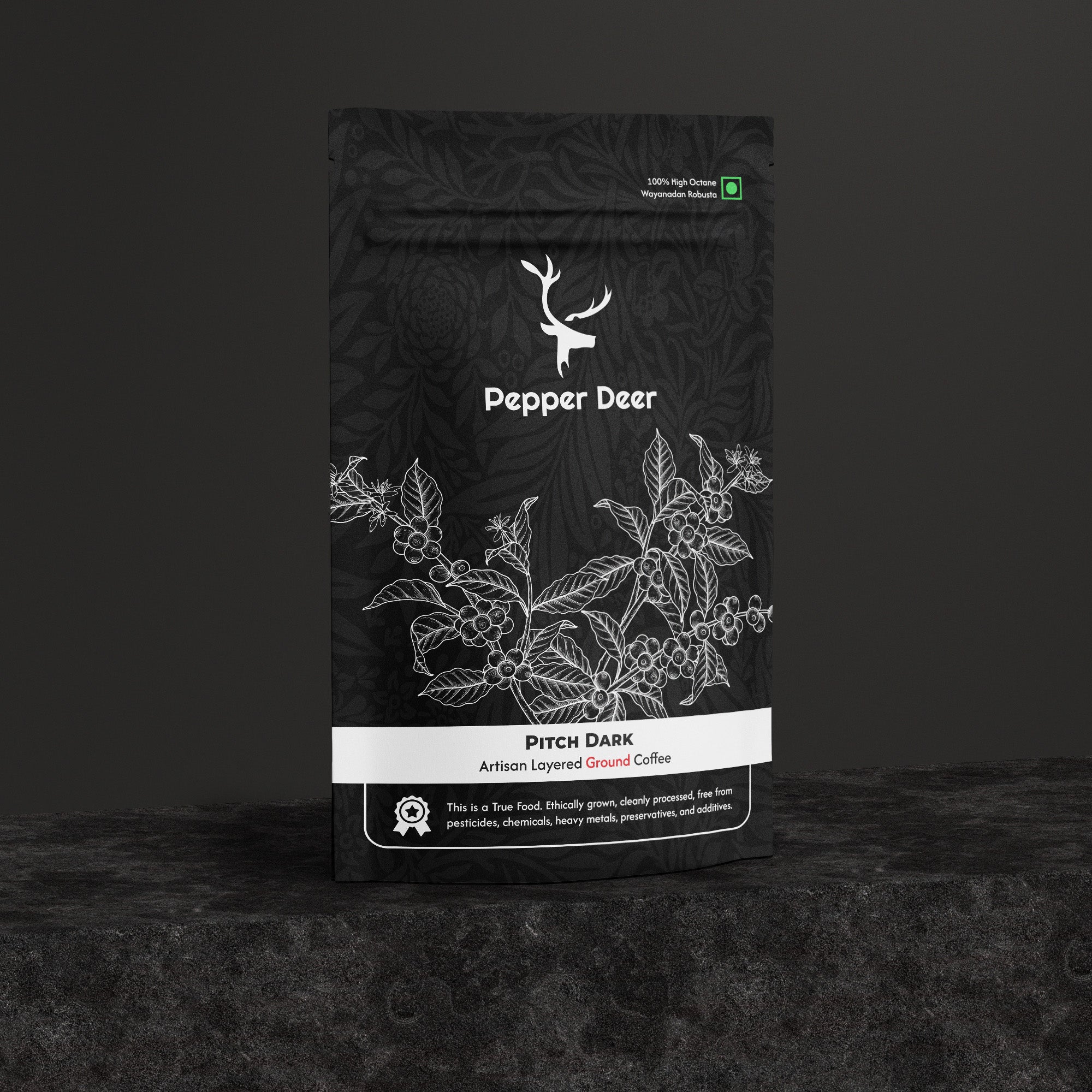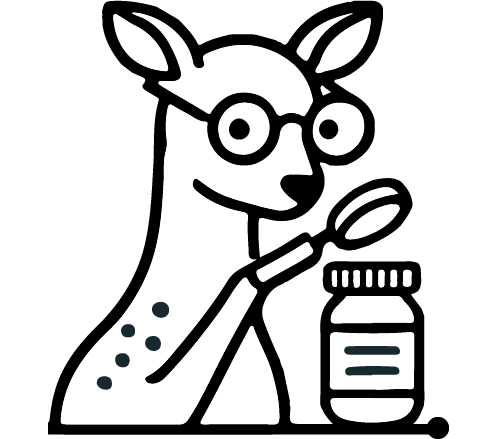Compliance and Purity Report for Pitch Dark, India’s Purest Coffee
The Indian coffee industry is experiencing an unprecedented transformation, driven by increasing consumer demand for authentic, traceable, and scientifically validated products. While "purity" is frequently used as a marketing buzzword, few brands provide verifiable, laboratory-backed evidence to substantiate such claims. This document has been prepared by Pepper Deer Pvt. Ltd. to formally present the scientific and regulatory foundation of Pitch Dark, our flagship 100% Robusta PeaBerry Coffee sourced from Wayanad, Kerala.
This whitepaper serves the following purpose:
To Demonstrate Full Compliance with National and International Food Safety Standards. Pitch Dark meets and exceeds the safety benchmarks outlined in the Food Safety and Standards Regulations (FSSR) 2011, including the absence of pesticide residues, non-detection of mycotoxins such as ochratoxin A, compliance with heavy metal safety thresholds, or free from synthetic adulterants like melamine.
Advanced analytical techniques such as LC-MS/MS, GC-MS/MS, ICP-MS, and ELISA were employed to establish this compliance, positioning Pitch Dark as a laboratory-certified safe and clean food product.
Pepper Deer’s mission is to restore consumer trust through transparency, uncompromising quality, and scientific rigor. This whitepaper is a formal declaration of that commitment. For additional technical clarifications, validation requests, or batch-specific reports, please contact compliance@pepperdeer.com
Analytical Profile of Pepper Deer Pitch Dark
This section details the analytical outcomes from a comprehensive test conducted on a 750g sample of Robusta Green Bean P-Berry coffee, taken from Internal batch W-001, sourced from Wayanad, Kerala.
All testing protocols referenced applicable IS standards, FSSR 2011 regulations, and internal SOPs certified under ISO and FSSAI frameworks.
Physical and Chemical Profile
This section presents the key physical and chemical parameters of the green coffee beans analyzed.
|
Parameter |
Value |
Method / SOP |
Notes |
|
Physical Description |
Green Bean P-Berry |
Visual Inspection |
Free from foreign matter |
|
Moisture Content |
4.04% |
SOP/01-60 (IS-2791) |
Within optimal limits for green coffee |
|
Ash Content |
5.29% |
SOP/01-60 |
Total ash, mineral residue post-combustion |
|
Acidity (pH) |
0.85 |
SOP/01-60 |
Indicates acid profile in aqueous extract |
Heavy Metals Screening
All values listed below are reported in mg/kg.
|
Metal |
Result |
LOQ (Detection Limit) |
Regulatory Limit (FSSR 2011) |
Status |
|
Lead (Pb) |
BLQ |
0.05 |
2.5 mg/kg |
Not Detected |
|
Copper (Cu) |
2.54 |
0.1 |
30 mg/kg |
Detected; Within Limits |
|
Arsenic (As) |
BLQ |
0.2 |
1.1 mg/kg |
Not Detected |
|
Tin (Sn) |
BLQ |
0.05 |
250 mg/kg |
Not Detected |
|
Mercury (Hg) |
BLQ |
0.02 |
1.0 mg/kg |
Not Detected |
|
Methyl Mercury |
BLQ |
0.02 |
0.25 mg/kg |
Not Detected |
Interpretation: The sample meets all relevant FSSR 2011 thresholds. Only copper is quantifiable and is well below permissible limits. All other heavy metals are below quantification thresholds.
Mycotoxins and Other Contaminants
Tests were conducted for key toxins and adulterants as per global and national food safety standards. Mycotoxins such as Ochratoxin A and Aflatoxins (B1, B2, G1, G2) are toxic secondary metabolites produced by certain fungi, commonly found in improperly stored or processed agricultural products. They are known to pose significant health risks even at low concentrations, including potential carcinogenic and nephrotoxic effects. Melamine, on the other hand, is an industrial chemical sometimes illegally added to increase apparent protein content, and its ingestion can lead to serious kidney damage. These contaminants are tightly regulated by both the FSSR 2011 and Codex Alimentarius due to their potential impact on human health.
|
Compound |
Result |
LOQ (µg/kg) |
FSSR Limit |
Notes |
|
Ochratoxin A |
BLQ |
0.5 |
0.5 µg/kg |
Below Limit of Quantification |
|
Aflatoxins (B1, B2, G1, G2) |
BLQ |
Not listed |
30 µg/kg |
Below detection levels |
|
Melamine |
BLQ |
Not listed |
NMT 2.5 mg/kg |
Not Detected |
Interpretation: Mycotoxin screening confirms no fungal contamination of concern. Absence of ochratoxin A is significant in coffee safety.
Agrochemical Residues: Fungicides, Insecticides, and Herbicides
The following copper-based compounds were found in equal quantities (2.54 mg/kg), each within safe tolerances: Copper Oxychloride, Copper Sulphate, and Cuprous Oxide. These compounds are used in approved organic or conventional fungicidal practices. All were detected at identical levels, suggesting a common copper source. Total copper reading (2.54 mg/kg) aligns with this.
Other Agricultural Chemical Residues (All BLQ)
|
Compound |
LOQ (mg/kg) |
Result |
|
Epoxyconazole (fungicide) |
0.01 |
BLQ |
|
Ethephon (growth regulator) |
0.01 |
BLQ |
|
Monocrotophos (organophosphate) |
0.01 |
BLQ |
|
Pyraclostrobin (fungicide) |
0.01 |
BLQ |
|
Triadimefon (fungicide) |
0.01 |
BLQ |
Pesticide Screening
The tested sample was analyzed for the presence of pesticide residues, using validated multi-residue analytical methods. The test methods followed include internal laboratory protocol FL/SOP/05-01, which complies with the Food Safety and Standards Regulations (FSSR), 2011, for pesticide residue testing in food commodities.
Instrumentation and analytical methods included Gas Chromatography–Mass Spectrometry (GC-MS/MS) and Liquid Chromatography–Mass Spectrometry (LC-MS/MS). These methods are appropriate for the quantification of pesticide residues across various chemical classes, including organochlorines, organophosphates, carbamates, and triazines.
The following pesticide residues were analyzed individually, and all results were reported as BLQ (Below Limit of Quantification).
|
S.No |
Compound Name |
Pesticide Class |
LOQ (mg/kg) |
Result |
|
1 |
Aldrin |
Organochlorine |
0.01 |
BLQ |
|
2 |
Dieldrin |
Organochlorine |
0.01 |
BLQ |
|
3 |
Chlordane |
Organochlorine |
0.01 |
BLQ |
|
4 |
Heptachlor |
Organochlorine |
0.01 |
BLQ |
|
5 |
Lindane (γ-HCH) |
Organochlorine |
0.01 |
BLQ |
|
6 |
Gamma-HCH |
Organochlorine |
0.01 |
BLQ |
|
7 |
Endosulfan |
Organochlorine |
0.01 |
BLQ |
|
8 |
Carbofuran |
Carbamate |
0.01 |
BLQ |
|
9 |
Methomyl |
Carbamate |
0.01 |
BLQ |
|
10 |
Diazinon |
Organophosphate |
0.01 |
BLQ |
|
11 |
Formothion |
Organophosphate |
0.01 |
BLQ |
|
12 |
Simazine |
Triazine Herbicide |
0.01 |
BLQ |
|
13 |
Phosalone |
Organophosphate |
0.01 |
BLQ |
|
14 |
Captan |
Fungicide |
0.01 |
BLQ |
|
15 |
Triadimefon |
Fungicide (Triazole) |
0.01 |
BLQ |
|
16 |
Pyraclostrobin |
Fungicide (Strobilurin) |
0.01 |
BLQ |
|
17 |
Epoxyconazole |
Fungicide (Triazole) |
0.01 |
BLQ |
|
18 |
Ethephon |
Plant growth regulator |
0.01 |
BLQ |
|
19 |
Monocrotophos |
Organophosphate |
0.01 |
BLQ |
|
20 |
Methyl Parathion |
Organophosphate |
0.01 |
BLQ |
|
21 |
Ethyl Parathion |
Organophosphate |
0.01 |
BLQ |
|
22 |
2,4-DDD |
Organochlorine/Metabolite |
0.05 |
BLQ |
|
23 |
4,4-DDD |
Organochlorine/Metabolite |
0.05 |
BLQ |
|
24 |
2,4-DDE |
Organochlorine/Metabolite |
0.05 |
BLQ |
|
25 |
4,4-DDE |
Organochlorine/Metabolite |
0.05 |
BLQ |
|
26 |
2,4-DDT |
Organochlorine |
0.05 |
BLQ |
|
27 |
4,4-DDT |
Organochlorine |
0.05 |
BLQ |
|
28 |
Fenitrothion |
Organophosphate |
0.01 |
BLQ |
|
29 |
Fenthion |
Organophosphate |
0.01 |
BLQ |
Each of these compounds has a specific Maximum Residue Limit (MRL) under FSSR 2011 or Codex Alimentarius. All results for the above analytes were Below the Limit of Quantification, reaffirming our commitment to keeping the product as close to pure as nature intended.
Methodologies Employed
A combination of sensitive and precise analytical techniques was employed to ensure thorough screening for contaminants. These methods were selected based on their suitability to detect specific classes of residues, toxins, and heavy metals, providing a comprehensive assessment of the sample’s safety and quality.
|
Technique |
Description |
Purpose |
|
LC-MS/MS |
Liquid Chromatography - Tandem Mass Spectrometry |
Used for multi-residue pesticide and mycotoxin screening |
|
GC-MS/MS |
Gas Chromatography - Tandem Mass Spectrometry |
Detection of volatile and persistent pesticides |
|
ICP-MS |
Inductively Coupled Plasma Mass Spectrometry |
Ultra-trace heavy metal analysis |
|
ELISA |
Enzyme-linked Immunosorbent Assay |
Mycotoxin and allergen detection |
These techniques are the global benchmark for food safety testing due to their ultra-trace detection capabilities and specificity.
Conclusion
This document presents the initial findings from independent testing conducted on Pepper Deer's Pitch Dark ground coffee. The intent has been to bring clarity to the product’s nutritional profile and contaminant safety, using transparent, third-party data as the basis.
Our hope is that this level of transparency becomes more common in the Indian packaged food and beverage space. We remain committed to ongoing testing and public disclosure, and welcome dialogue with experts, regulators, and fellow producers in improving standards across the board.
This whitepaper is shared in that spirit.
A Note from the Co-founder
Hello,
This document is just a small step toward what we’re trying to build.
We know we won’t get everything right, and there’s still a long way to go. If something’s unclear or if there’s a better way to do things, we’re open to learning. But if there’s one thing we’re sure of. It’s that food should be honest. That belief is what led us here.
Thank you for reading this. And thank you, especially, for expecting better from the food you eat.
On behalf of all of us at Pepper Deer,
Glint Ace Kuriakose,
The Ops Guy.
Legal Disclaimer
This whitepaper is prepared for informational purposes only and is based on test results provided by independent third-party laboratories. While Pepper Deer has exercised due diligence in selecting accredited and reputable laboratories and in compiling the data presented herein, Pepper Deer does not guarantee the absolute accuracy, completeness, or reliability of the test results or any conclusions drawn from them.
The analyses reflect the specific samples tested at a particular time and under defined conditions. Due to natural variations inherent in agricultural products and possible variations in testing procedures, results may vary between different batches, harvests, or laboratory assessments. Therefore, the data contained in this whitepaper should not be construed as a definitive or permanent representation.
Regulatory limits and standards referenced in this report (including but not limited to FSSR 2011 and Codex Alimentarius) are subject to change, and compliance is indicated only as per the requirements current at the time of testing (25 April 2025). Pepper Deer disclaims any responsibility or liability for non-compliance arising from changes in regulations after the date of this report (15 May 2025).
This whitepaper and its contents are not intended to serve as a warranty, guarantee, or certification of any kind. Pepper Deer expressly disclaims any liability for any loss, damage, or claim arising from the use, reliance upon, or interpretation of the information contained herein.
All proprietary methods, processes, and data referenced are confidential and remain the intellectual property of Pepper Deer and its partners. Unauthorized reproduction, distribution, or disclosure of this document or its contents is strictly prohibited.

